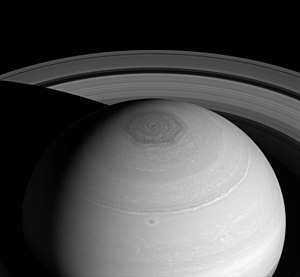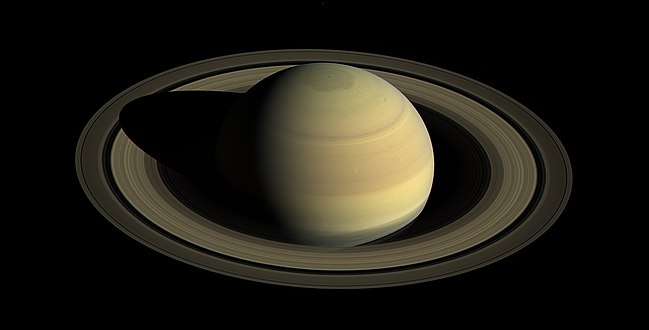Saturn's hexagon
Saturn's hexagon is a persisting hexagonal cloud pattern around the north pole of the planet Saturn, located at about 78°N.[1][2][3] The sides of the hexagon are about 14,500 km (9,000 mi) long,[4][5][6][7] which is about 2,000 km (1,200 mi) longer than the diameter of Earth.[8] The hexagon may be a bit greater than 29,000 km (18,000 mi) wide,[9] may be 300 km (190 mi) high, and may be a jet stream made of atmospheric gases moving at 320 km/h (200 mph).[4][5][10] It rotates with a period of 10h 39m 24s, the same period as Saturn's radio emissions from its interior.[11] The hexagon does not shift in longitude like other clouds in the visible atmosphere.[12]


Saturn's hexagon was discovered during the Voyager mission in 1981 and was later revisited by Cassini-Huygens in 2006. During the Cassini mission, the hexagon changed from a mostly blue color to more of a golden color. Saturn's south pole does not have a hexagon, as verified by Hubble observations. It does, however, have a vortex, and there is also a vortex inside the northern hexagon.[13] Multiple hypotheses for the hexagonal cloud pattern have been developed.
Discovery
Saturn's polar hexagon was discovered by the Voyager mission in 1981,[14] and it was revisited in 2006 by Cassini mission.[15]
Cassini was able to take only thermal infrared images of the hexagon until it passed into sunlight in January 2009.[16] Cassini was also able to take a video of the hexagonal weather pattern while traveling at the same speed as the planet, therefore recording only the movement of the hexagon.[17] After its discovery, and after it came back into the sunlight, amateur astronomers managed to get images showing the hexagon from Earth.[18]
Color

Between 2012 and 2016, the hexagon changed from a mostly blue color to more of a golden color.[19] One theory for this is that sunlight is creating haze as the pole is exposed to sunlight due to the change in season. These changes were observed by the Cassini spacecraft.[19]
Explanations for hexagon shape

One hypothesis, developed at Oxford University, is that the hexagon forms where there is a steep latitudinal gradient in the speed of the atmospheric winds in Saturn's atmosphere.[20] Similar regular shapes were created in the laboratory when a circular tank of liquid was rotated at different speeds at its centre and periphery. The most common shape was six sided, but shapes with three to eight sides were also produced. The shapes form in an area of turbulent flow between the two different rotating fluid bodies with dissimilar speeds.[20][21] A number of stable vortices of similar size form on the slower (south) side of the fluid boundary and these interact with each other to space themselves out evenly around the perimeter. The presence of the vortices influences the boundary to move northward where each is present and this gives rise to the polygon effect.[21] Polygons do not form at wind boundaries unless the speed differential and viscosity parameters are within certain margins and so are not present at other likely places, such as Saturn's south pole or the poles of Jupiter.
Other researchers claim that lab studies exhibit vortex streets, a series of spiraling vortices not observed in Saturn's hexagon. Simulations show that a shallow, slow, localized meandering jetstream in the same direction as Saturn's prevailing clouds is able to match the observed behaviors of Saturn's Hexagon with the same boundary stability.[22]
Developing barotropic instability of Saturn's North Polar hexagonal circumpolar jet (Jet) plus North Polar vortex (NPV) system produces a long-living structure akin to the observed hexagon, which is not the case of the Jet-only system, which was studied in this context in a number of papers in literature. The north polar vortex (NPV), thus, plays a decisive dynamical role to stabilize hexagon jets. The influence of moist convection, which was recently suggested to be at the origin of Saturn's north polar vortex system in the literature, is investigated in the framework of the barotropic rotating shallow water model and does not alter the conclusions.[23]
See also
- Titanian Polar Vortices
References
- Godfrey, D.A. (1988). "A hexagonal feature around Saturn's north pole". Icarus. 76 (2): 335–56. Bibcode:1988Icar...76..335G. doi:10.1016/0019-1035(88)90075-9.
- Sanchez-Lavega, A.; Lecacheux, J.; Colas, F.; Laques, P. (1993). "Ground-Based Observations of Saturn's North Polar Spot and Hexagon". Science. 260 (5106): 329–32. Bibcode:1993Sci...260..329S. doi:10.1126/science.260.5106.329. PMID 17838249.
- Overbye, Dennis (August 6, 2014). "Storm Chasing on Saturn". New York Times. Retrieved August 6, 2014.
- Sánchez-Lavega, A.; et al. (7 March 2014). "The long-term steady motion of Saturn's hexagon and the stability of its enclosed jet stream under seasonal changes". Geophysical Research Letters. 41 (5): 1425–1431. doi:10.1002/2013GL059078.
- Fletcher, L.N.; et al. (3 September 2018). "A hexagon in Saturn's northern stratosphere surrounding the emerging summertime polar vortex". Nature Communications. 9 (3564): 3564. doi:10.1038/s41467-018-06017-3. PMC 6120878. PMID 30177694.
- Imster, Eleanor (12 August 2014). "The Eye of Saturn". Earth & Sky. Retrieved 13 September 2018.
- Williams, Matt (10 May 2017). "Saturn's Hexagon Will be the Star of the Cassini Finale". Universe Today. Retrieved 13 September 2018.
- "New images show Saturn's weird hexagon cloud". NBC News. December 12, 2009. Retrieved December 5, 2013.
- NOTE: A planar hexagon width (diameter) is twice the side (radius); but since the planet Saturn approximates an oblate spheroid, the radius of such an hexagon may be a bit greater than its side length (ie, 14,500 km), making the width (diameter) a bit greater than 29,000 km.
- Wall, Mike (4 September 2018). "Bizarre Hexagon on Saturn May Be 180 Miles Tall". Space.com. Retrieved 4 September 2018.
- Godfrey, D. A. (1990). "The Rotation Period of Saturn's Polar Hexagon". Science. 247 (4947): 1206–8. Bibcode:1990Sci...247.1206G. doi:10.1126/science.247.4947.1206. PMID 17809277.
- Baines, Kevin H.; Momary, Thomas W.; Fletcher, Leigh N.; Showman, Adam P.; Roos-Serote, Maarten; Brown, Robert H.; Buratti, Bonnie J.; Clark, Roger N.; Nicholson, Philip D. (2009). "Saturn's north polar cyclone and hexagon at depth revealed by Cassini/VIMS". Planetary and Space Science. 57 (14–15): 1671–81. Bibcode:2009P&SS...57.1671B. doi:10.1016/j.pss.2009.06.026.
- Sánchez-Lavega, A.; Pérez-Hoyos, S.; French, R. G. (2002). "Hubble Space Telescope Observations of the Atmospheric Dynamics in Saturn's South Pole from 1997 to 2002". American Astronomical Society. 34: 13.07. Bibcode:2002DPS....34.1307S. Archived from the original on September 5, 2008.
- Caldwell, John; Turgeon, Benoit; Hua, Xin-Min; Barnet, Christopher D.; Westphal, James A. (1993). "The Drift of Saturn's North Polar Spot Observed by the Hubble Space Telescope". Science. 260 (5106): 326–9. Bibcode:1993Sci...260..326C. doi:10.1126/science.260.5106.326. PMID 17838248.
- "Saturn's Strange Hexagon". NASA. March 27, 2007. Retrieved May 1, 2013.
- "Saturn's Mysterious Hexagon Emerges From Winter Darkness". NASA. December 9, 2009. Archived from the original on April 24, 2016. Retrieved May 1, 2013.
- Staff (December 4, 2013). "NASA's Cassini Spacecraft Obtains Best Views of Saturn Hexagon". Jet Propulsion Laboratory (NASA). Retrieved December 5, 2013.
- Fletcher, Leigh (January 31, 2013). "Saturn's Hexagon Viewed from the Ground". Planetary Wanderings.
- Staff (October 21, 2016). "Changing Colors in Saturn's North". NASA. Retrieved December 26, 2016.
- Barbosa Aguiar, Ana C.; Read, Peter L.; Wordsworth, Robin D.; Salter, Tara; Hiro Yamazaki, Y. (2010). "A laboratory model of Saturn's North Polar Hexagon". Icarus. 206 (2): 755–63. Bibcode:2010Icar..206..755B. doi:10.1016/j.icarus.2009.10.022.
- Lakdawalla, Emily (May 4, 2010). "Saturn's hexagon recreated in the laboratory". Planetary.org. Retrieved 2014-02-07.
- Morales-Juberías, R.; Sayanagi, K. M.; Simon, A. A.; Fletcher, L. N.; Cosentino, R. G. (2015). "Meandering Shallow Atmospheric Jet As a Model of Saturnʼs North-Polar Hexagon". The Astrophysical Journal. 806 (1): L18. Bibcode:2015ApJ...806L..18M. doi:10.1088/2041-8205/806/1/L18.
- Rostami, Masoud; Zeitlin, Vladimir; Spiga, Aymeric (2017). "On the dynamical nature of Saturn's North Polar hexagon" (PDF). Icarus. 297: 59–70. Bibcode:2017Icar..297...59R. doi:10.1016/j.icarus.2017.06.006.
External links
| Wikimedia Commons has media related to: |
- Cassini Video of Saturn's Hexagon on YouTube
- Saturn Revolution 175, Cassini images, November 27, 2012
- Saturn’s Strange Hexagon – In Living Color! - Universe Today
- Edge of the hexagon from Planetary Photojournal
- Saturn's Hexagon Comes to Light, APOD January 22, 2012
- In the Center of Saturn's North Polar Vortex, Astronomy Picture of the Day - December 4, 2012
- Video of hexagon's rotation from NASA
- NASA's Cassini Spacecraft Obtains Best Views of Saturn Hexagon (December 4, 2013)
- Animated vortex view (TPS)
- Hexagon image
- Saturn's Hexagon Replicated In Laboratory, video
- Hexagon Changes Color (October 21, 2016)
.jpg)

.jpg)